Analyzing Social Psychology: Aggression, Identity, Prejudice
VerifiedAdded on 2022/08/22
|7
|1451
|22
Essay
AI Summary
This essay delves into key concepts within social psychology, examining the influence of culture on aggressive behavior, the dynamics of social identity theory, and the multifaceted nature of prejudice. Part A discusses how cultural factors and social situations contribute to aggression, contrasting innate views with sociological perspectives, and emphasizing the role of self-esteem and interpersonal conflicts. Part B introduces social identity theory, explaining its origins, psychological factors, and implications for understanding group dynamics and biases. Finally, Part C explores the various components of prejudice, including cognitive, stereotypical, in-group favoritism, and affective prejudices, highlighting their impact on social categorization and discrimination. The essay uses real-world examples and references to support its arguments, providing a comprehensive overview of these critical social psychology concepts.
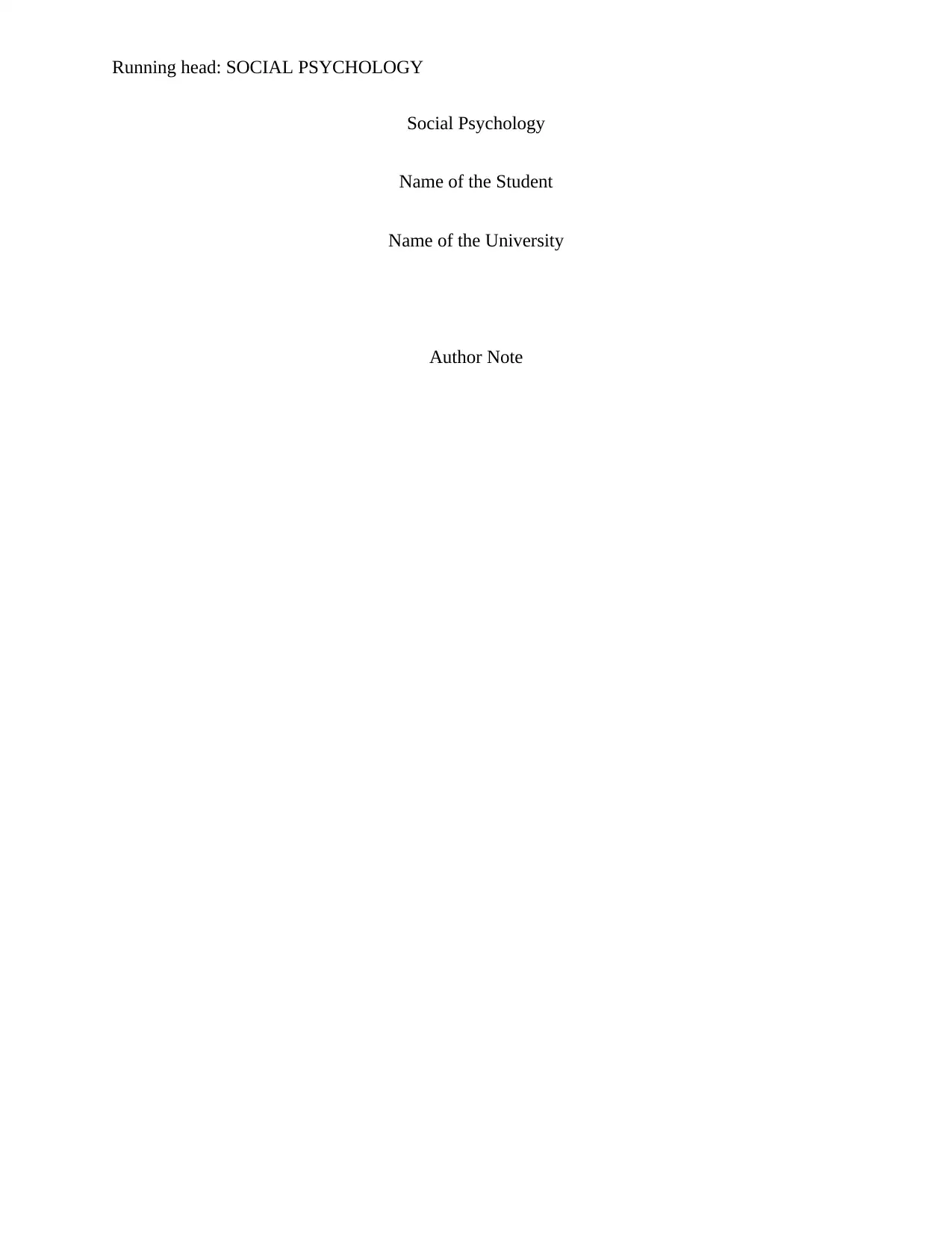
Running head: SOCIAL PSYCHOLOGY
Social Psychology
Name of the Student
Name of the University
Author Note
Social Psychology
Name of the Student
Name of the University
Author Note
Paraphrase This Document
Need a fresh take? Get an instant paraphrase of this document with our AI Paraphraser
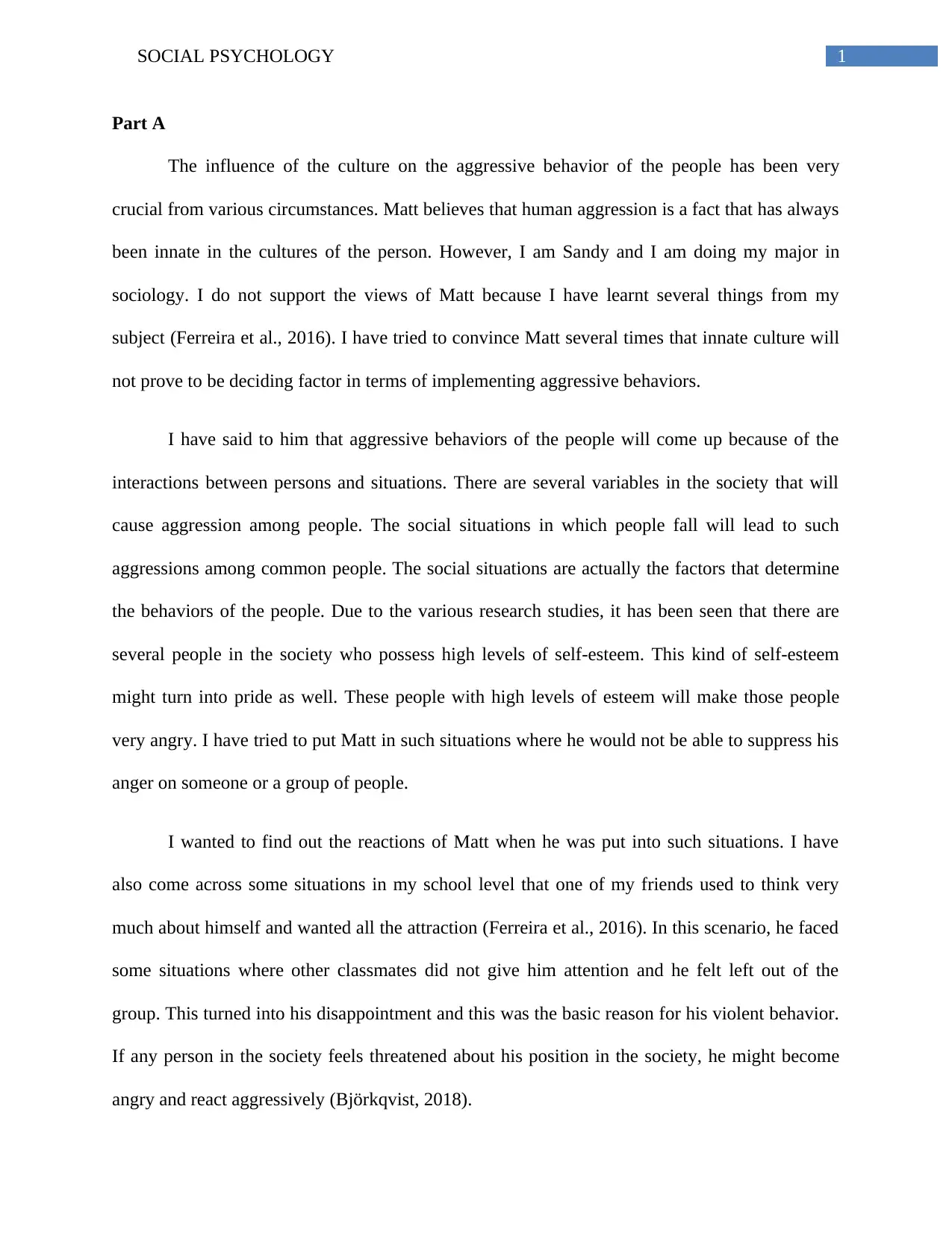
1SOCIAL PSYCHOLOGY
Part A
The influence of the culture on the aggressive behavior of the people has been very
crucial from various circumstances. Matt believes that human aggression is a fact that has always
been innate in the cultures of the person. However, I am Sandy and I am doing my major in
sociology. I do not support the views of Matt because I have learnt several things from my
subject (Ferreira et al., 2016). I have tried to convince Matt several times that innate culture will
not prove to be deciding factor in terms of implementing aggressive behaviors.
I have said to him that aggressive behaviors of the people will come up because of the
interactions between persons and situations. There are several variables in the society that will
cause aggression among people. The social situations in which people fall will lead to such
aggressions among common people. The social situations are actually the factors that determine
the behaviors of the people. Due to the various research studies, it has been seen that there are
several people in the society who possess high levels of self-esteem. This kind of self-esteem
might turn into pride as well. These people with high levels of esteem will make those people
very angry. I have tried to put Matt in such situations where he would not be able to suppress his
anger on someone or a group of people.
I wanted to find out the reactions of Matt when he was put into such situations. I have
also come across some situations in my school level that one of my friends used to think very
much about himself and wanted all the attraction (Ferreira et al., 2016). In this scenario, he faced
some situations where other classmates did not give him attention and he felt left out of the
group. This turned into his disappointment and this was the basic reason for his violent behavior.
If any person in the society feels threatened about his position in the society, he might become
angry and react aggressively (Björkqvist, 2018).
Part A
The influence of the culture on the aggressive behavior of the people has been very
crucial from various circumstances. Matt believes that human aggression is a fact that has always
been innate in the cultures of the person. However, I am Sandy and I am doing my major in
sociology. I do not support the views of Matt because I have learnt several things from my
subject (Ferreira et al., 2016). I have tried to convince Matt several times that innate culture will
not prove to be deciding factor in terms of implementing aggressive behaviors.
I have said to him that aggressive behaviors of the people will come up because of the
interactions between persons and situations. There are several variables in the society that will
cause aggression among people. The social situations in which people fall will lead to such
aggressions among common people. The social situations are actually the factors that determine
the behaviors of the people. Due to the various research studies, it has been seen that there are
several people in the society who possess high levels of self-esteem. This kind of self-esteem
might turn into pride as well. These people with high levels of esteem will make those people
very angry. I have tried to put Matt in such situations where he would not be able to suppress his
anger on someone or a group of people.
I wanted to find out the reactions of Matt when he was put into such situations. I have
also come across some situations in my school level that one of my friends used to think very
much about himself and wanted all the attraction (Ferreira et al., 2016). In this scenario, he faced
some situations where other classmates did not give him attention and he felt left out of the
group. This turned into his disappointment and this was the basic reason for his violent behavior.
If any person in the society feels threatened about his position in the society, he might become
angry and react aggressively (Björkqvist, 2018).
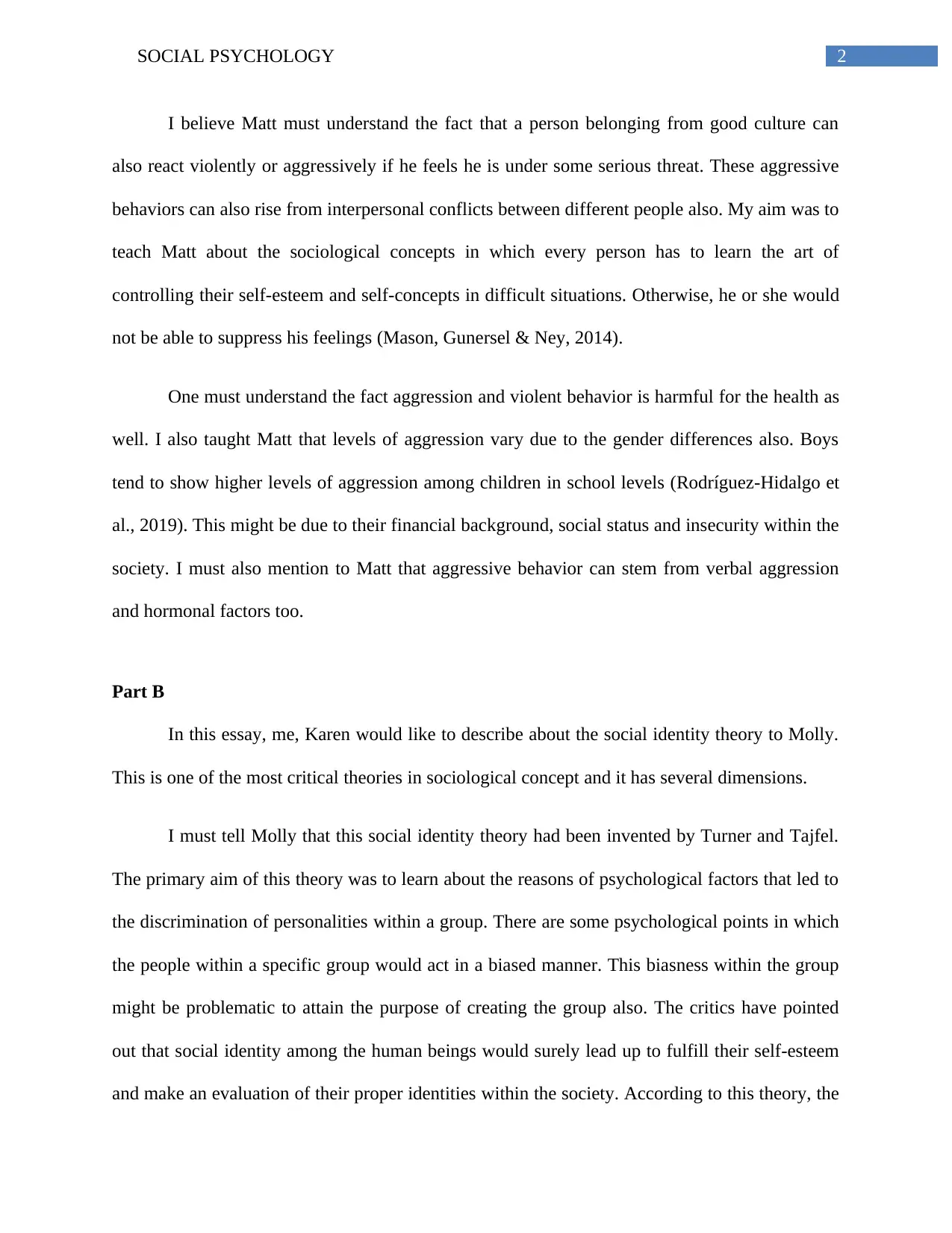
2SOCIAL PSYCHOLOGY
I believe Matt must understand the fact that a person belonging from good culture can
also react violently or aggressively if he feels he is under some serious threat. These aggressive
behaviors can also rise from interpersonal conflicts between different people also. My aim was to
teach Matt about the sociological concepts in which every person has to learn the art of
controlling their self-esteem and self-concepts in difficult situations. Otherwise, he or she would
not be able to suppress his feelings (Mason, Gunersel & Ney, 2014).
One must understand the fact aggression and violent behavior is harmful for the health as
well. I also taught Matt that levels of aggression vary due to the gender differences also. Boys
tend to show higher levels of aggression among children in school levels (Rodríguez-Hidalgo et
al., 2019). This might be due to their financial background, social status and insecurity within the
society. I must also mention to Matt that aggressive behavior can stem from verbal aggression
and hormonal factors too.
Part B
In this essay, me, Karen would like to describe about the social identity theory to Molly.
This is one of the most critical theories in sociological concept and it has several dimensions.
I must tell Molly that this social identity theory had been invented by Turner and Tajfel.
The primary aim of this theory was to learn about the reasons of psychological factors that led to
the discrimination of personalities within a group. There are some psychological points in which
the people within a specific group would act in a biased manner. This biasness within the group
might be problematic to attain the purpose of creating the group also. The critics have pointed
out that social identity among the human beings would surely lead up to fulfill their self-esteem
and make an evaluation of their proper identities within the society. According to this theory, the
I believe Matt must understand the fact that a person belonging from good culture can
also react violently or aggressively if he feels he is under some serious threat. These aggressive
behaviors can also rise from interpersonal conflicts between different people also. My aim was to
teach Matt about the sociological concepts in which every person has to learn the art of
controlling their self-esteem and self-concepts in difficult situations. Otherwise, he or she would
not be able to suppress his feelings (Mason, Gunersel & Ney, 2014).
One must understand the fact aggression and violent behavior is harmful for the health as
well. I also taught Matt that levels of aggression vary due to the gender differences also. Boys
tend to show higher levels of aggression among children in school levels (Rodríguez-Hidalgo et
al., 2019). This might be due to their financial background, social status and insecurity within the
society. I must also mention to Matt that aggressive behavior can stem from verbal aggression
and hormonal factors too.
Part B
In this essay, me, Karen would like to describe about the social identity theory to Molly.
This is one of the most critical theories in sociological concept and it has several dimensions.
I must tell Molly that this social identity theory had been invented by Turner and Tajfel.
The primary aim of this theory was to learn about the reasons of psychological factors that led to
the discrimination of personalities within a group. There are some psychological points in which
the people within a specific group would act in a biased manner. This biasness within the group
might be problematic to attain the purpose of creating the group also. The critics have pointed
out that social identity among the human beings would surely lead up to fulfill their self-esteem
and make an evaluation of their proper identities within the society. According to this theory, the
⊘ This is a preview!⊘
Do you want full access?
Subscribe today to unlock all pages.

Trusted by 1+ million students worldwide
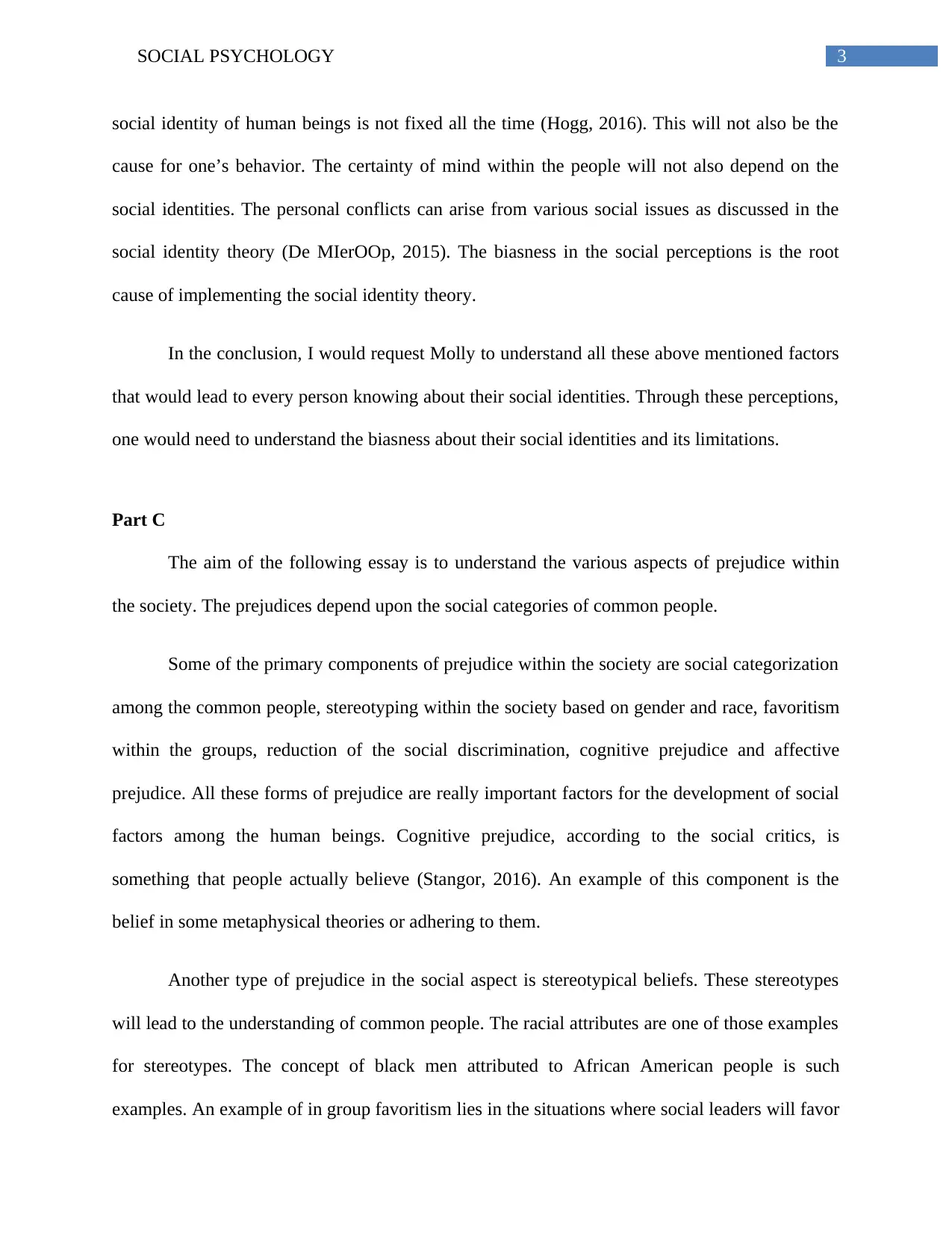
3SOCIAL PSYCHOLOGY
social identity of human beings is not fixed all the time (Hogg, 2016). This will not also be the
cause for one’s behavior. The certainty of mind within the people will not also depend on the
social identities. The personal conflicts can arise from various social issues as discussed in the
social identity theory (De MIerOOp, 2015). The biasness in the social perceptions is the root
cause of implementing the social identity theory.
In the conclusion, I would request Molly to understand all these above mentioned factors
that would lead to every person knowing about their social identities. Through these perceptions,
one would need to understand the biasness about their social identities and its limitations.
Part C
The aim of the following essay is to understand the various aspects of prejudice within
the society. The prejudices depend upon the social categories of common people.
Some of the primary components of prejudice within the society are social categorization
among the common people, stereotyping within the society based on gender and race, favoritism
within the groups, reduction of the social discrimination, cognitive prejudice and affective
prejudice. All these forms of prejudice are really important factors for the development of social
factors among the human beings. Cognitive prejudice, according to the social critics, is
something that people actually believe (Stangor, 2016). An example of this component is the
belief in some metaphysical theories or adhering to them.
Another type of prejudice in the social aspect is stereotypical beliefs. These stereotypes
will lead to the understanding of common people. The racial attributes are one of those examples
for stereotypes. The concept of black men attributed to African American people is such
examples. An example of in group favoritism lies in the situations where social leaders will favor
social identity of human beings is not fixed all the time (Hogg, 2016). This will not also be the
cause for one’s behavior. The certainty of mind within the people will not also depend on the
social identities. The personal conflicts can arise from various social issues as discussed in the
social identity theory (De MIerOOp, 2015). The biasness in the social perceptions is the root
cause of implementing the social identity theory.
In the conclusion, I would request Molly to understand all these above mentioned factors
that would lead to every person knowing about their social identities. Through these perceptions,
one would need to understand the biasness about their social identities and its limitations.
Part C
The aim of the following essay is to understand the various aspects of prejudice within
the society. The prejudices depend upon the social categories of common people.
Some of the primary components of prejudice within the society are social categorization
among the common people, stereotyping within the society based on gender and race, favoritism
within the groups, reduction of the social discrimination, cognitive prejudice and affective
prejudice. All these forms of prejudice are really important factors for the development of social
factors among the human beings. Cognitive prejudice, according to the social critics, is
something that people actually believe (Stangor, 2016). An example of this component is the
belief in some metaphysical theories or adhering to them.
Another type of prejudice in the social aspect is stereotypical beliefs. These stereotypes
will lead to the understanding of common people. The racial attributes are one of those examples
for stereotypes. The concept of black men attributed to African American people is such
examples. An example of in group favoritism lies in the situations where social leaders will favor
Paraphrase This Document
Need a fresh take? Get an instant paraphrase of this document with our AI Paraphraser
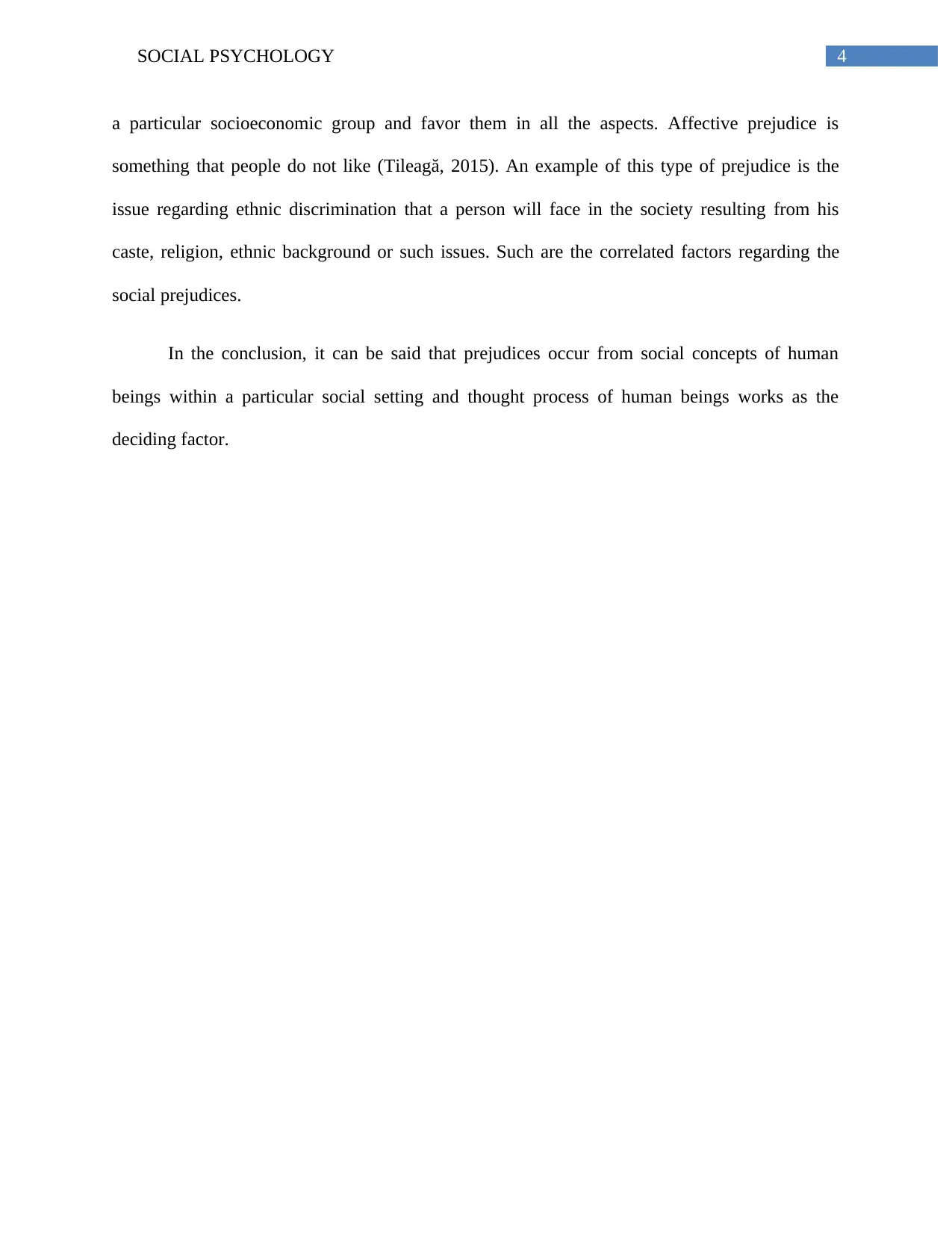
4SOCIAL PSYCHOLOGY
a particular socioeconomic group and favor them in all the aspects. Affective prejudice is
something that people do not like (Tileagă, 2015). An example of this type of prejudice is the
issue regarding ethnic discrimination that a person will face in the society resulting from his
caste, religion, ethnic background or such issues. Such are the correlated factors regarding the
social prejudices.
In the conclusion, it can be said that prejudices occur from social concepts of human
beings within a particular social setting and thought process of human beings works as the
deciding factor.
a particular socioeconomic group and favor them in all the aspects. Affective prejudice is
something that people do not like (Tileagă, 2015). An example of this type of prejudice is the
issue regarding ethnic discrimination that a person will face in the society resulting from his
caste, religion, ethnic background or such issues. Such are the correlated factors regarding the
social prejudices.
In the conclusion, it can be said that prejudices occur from social concepts of human
beings within a particular social setting and thought process of human beings works as the
deciding factor.
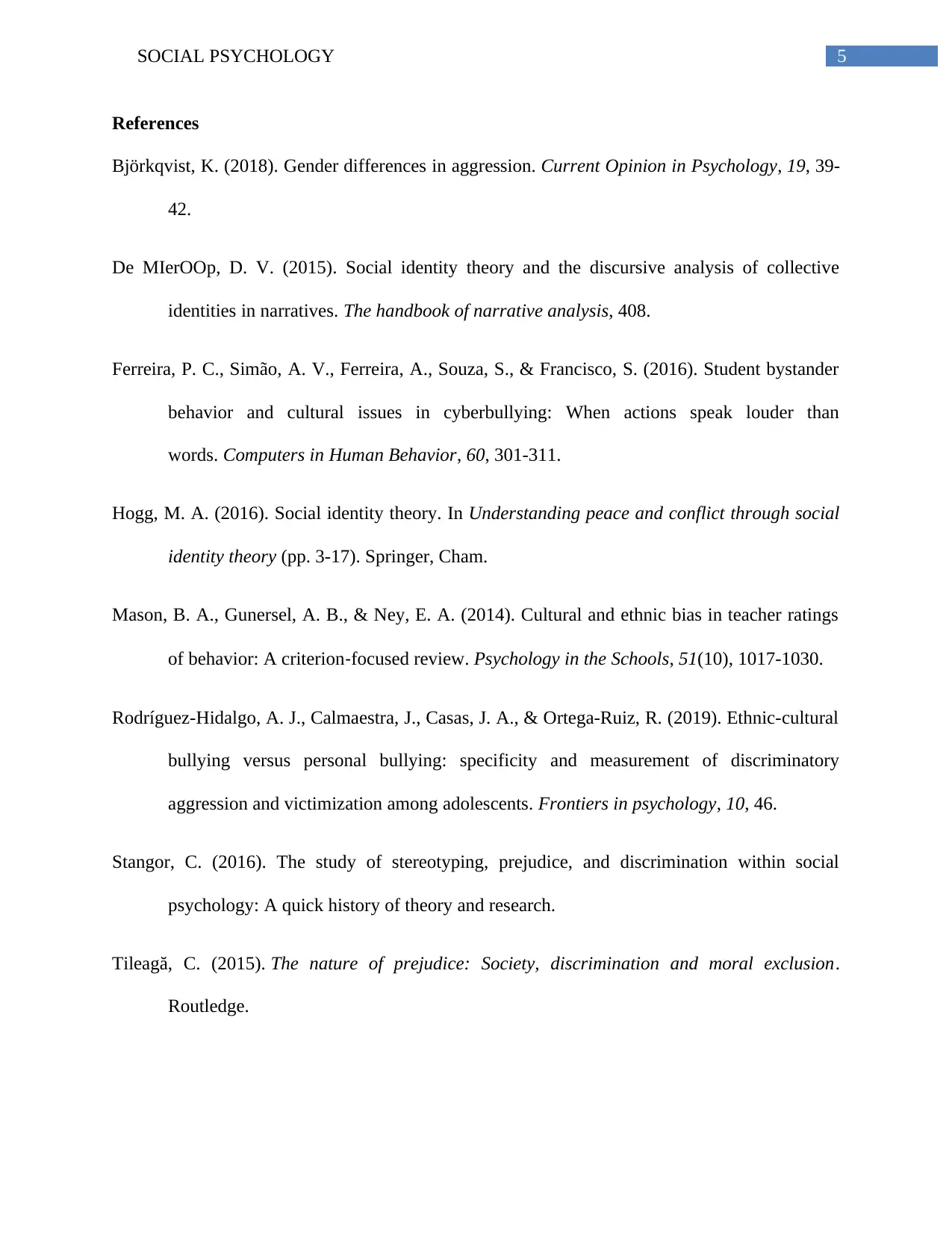
5SOCIAL PSYCHOLOGY
References
Björkqvist, K. (2018). Gender differences in aggression. Current Opinion in Psychology, 19, 39-
42.
De MIerOOp, D. V. (2015). Social identity theory and the discursive analysis of collective
identities in narratives. The handbook of narrative analysis, 408.
Ferreira, P. C., Simão, A. V., Ferreira, A., Souza, S., & Francisco, S. (2016). Student bystander
behavior and cultural issues in cyberbullying: When actions speak louder than
words. Computers in Human Behavior, 60, 301-311.
Hogg, M. A. (2016). Social identity theory. In Understanding peace and conflict through social
identity theory (pp. 3-17). Springer, Cham.
Mason, B. A., Gunersel, A. B., & Ney, E. A. (2014). Cultural and ethnic bias in teacher ratings
of behavior: A criterion‐focused review. Psychology in the Schools, 51(10), 1017-1030.
Rodríguez-Hidalgo, A. J., Calmaestra, J., Casas, J. A., & Ortega-Ruiz, R. (2019). Ethnic-cultural
bullying versus personal bullying: specificity and measurement of discriminatory
aggression and victimization among adolescents. Frontiers in psychology, 10, 46.
Stangor, C. (2016). The study of stereotyping, prejudice, and discrimination within social
psychology: A quick history of theory and research.
Tileagă, C. (2015). The nature of prejudice: Society, discrimination and moral exclusion.
Routledge.
References
Björkqvist, K. (2018). Gender differences in aggression. Current Opinion in Psychology, 19, 39-
42.
De MIerOOp, D. V. (2015). Social identity theory and the discursive analysis of collective
identities in narratives. The handbook of narrative analysis, 408.
Ferreira, P. C., Simão, A. V., Ferreira, A., Souza, S., & Francisco, S. (2016). Student bystander
behavior and cultural issues in cyberbullying: When actions speak louder than
words. Computers in Human Behavior, 60, 301-311.
Hogg, M. A. (2016). Social identity theory. In Understanding peace and conflict through social
identity theory (pp. 3-17). Springer, Cham.
Mason, B. A., Gunersel, A. B., & Ney, E. A. (2014). Cultural and ethnic bias in teacher ratings
of behavior: A criterion‐focused review. Psychology in the Schools, 51(10), 1017-1030.
Rodríguez-Hidalgo, A. J., Calmaestra, J., Casas, J. A., & Ortega-Ruiz, R. (2019). Ethnic-cultural
bullying versus personal bullying: specificity and measurement of discriminatory
aggression and victimization among adolescents. Frontiers in psychology, 10, 46.
Stangor, C. (2016). The study of stereotyping, prejudice, and discrimination within social
psychology: A quick history of theory and research.
Tileagă, C. (2015). The nature of prejudice: Society, discrimination and moral exclusion.
Routledge.
⊘ This is a preview!⊘
Do you want full access?
Subscribe today to unlock all pages.

Trusted by 1+ million students worldwide

6SOCIAL PSYCHOLOGY
1 out of 7
Related Documents
Your All-in-One AI-Powered Toolkit for Academic Success.
+13062052269
info@desklib.com
Available 24*7 on WhatsApp / Email
![[object Object]](/_next/static/media/star-bottom.7253800d.svg)
Unlock your academic potential
Copyright © 2020–2025 A2Z Services. All Rights Reserved. Developed and managed by ZUCOL.





